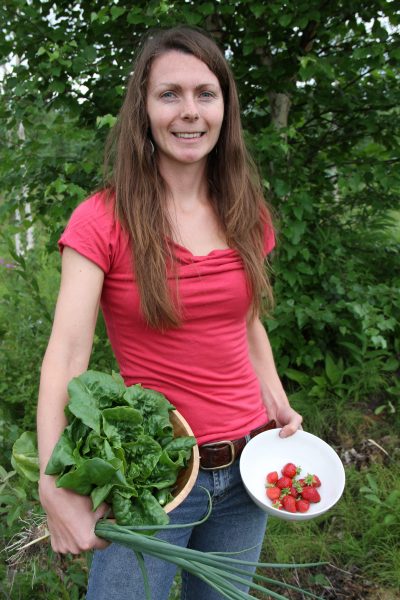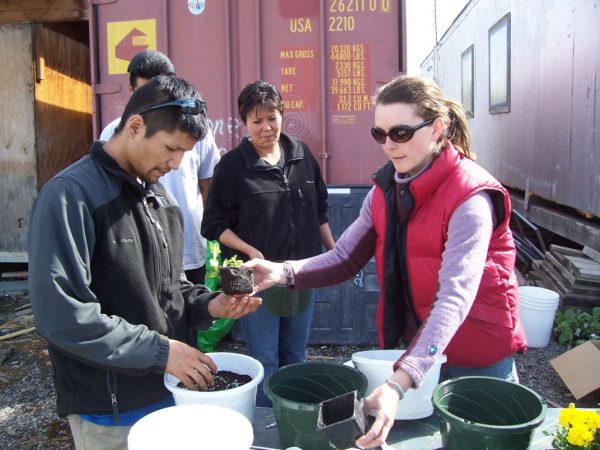Teaching rural Alaska to farm is Rader's passion
June 2, 2016
Debbie Carter
907-474-5406

Heidi Rader planned to become a farmer when she graduated from college.
During high school and college, she worked a succession of jobs at Ann’s Greenhouses, Basically Basil and Calypso Farm that seemed to be leading to an agricultural career. For her master’s degree in natural resources management, she grew snap beans and lettuce, and studied high-tunnel production at the Fairbanks Experiment Farm.
A few months after she graduated, however, she learned about a job with the Cooperative Extension Service and the Tanana Chiefs Conference that sounded appealing. The job, as a tribes Extension educator, was to help people with gardening, farming and food preservation. She liked the idea of applying and sharing research with the public.
“It was practical science,” she said.
Rader knew a lot about gardening and farming, but needed to bone up on food preservation for the new job. Working with Extension home economist Roxie Dinstel, she learned basic techniques and how to use a pressure canner, make sausage and can salmon.
Since 2007, Rader has delivered workshops in nearly 30 villages and communities, including Arctic Village in the foothills of the Brooks Range, Shageluk and Holy Cross on the lower Yukon River, and Dot Lake near Tok. She teaches whatever a community requests from a list of workshops she has developed. They include topics like making jam, cooking fresh foods from the garden, seed starting, composting with worms, extending the growing season and even applying for grants.
Shortly after coming to Extension, she developed an online version of the Alaska Master Gardener Program to reach individuals around the state who couldn’t attend regularly scheduled sessions. This summer’s class filled a month before it was scheduled to begin, with a wait list of 15.
Although Rader likes teaching hands-on workshops, she’s also been motivated to find different ways to reach far-flung audiences. Two years in a row, while attempting to teach workshops in Minto and Circle, she was turned back by snowdrifts on the road.
She has experimented with different delivery methods with the Alaska Growers School, an agricultural training she developed in 2011 that teaches the basics of farming and ranching. It initially included training in Fairbanks and a practicum at Calypso Farms, but now consists of a series of weekly webinars and teleconferences. The sessions begin June 8 and will be geared to Alaska Natives and others affiliated with Native entities who want to start farming. The school’s focus and delivery method have shifted with various U.S. Department of Agriculture funding sources.

Rader is also developing a mobile app called Grow & Tell, which allows individuals in Alaska and other parts of North America to note where they are growing a particular variety of vegetable — and see what varieties others are growing and how well they have done. She is working with a Boston software company on the app, with funding from an Extension foundation.
“It’s basically citizen science agricultural variety trials,” she said.
Some 30 to 50 Alaska volunteers are beta testing the app, which Rader hopes will be available to the public this summer. She received a 2016 Invent Alaska Award from the University of Alaska Fairbanks in May for her work on the app.
Rader says she picks up ideas wherever she goes, which leads to new projects. She started the Alaska Master Gardener Blog so people could communicate about what they were growing. A gardener in Tok posted an item about the garlic she grew. The popularity of that posting made Rader realize that others were interested in growing garlic. She has since developed a publication, “Growing Garlic in Alaska,” and a YouTube video on the subject.
Extension Director Fred Schlutt said Rader is always looking for better ways to do her job and is very focused on her work.
“Everything she does is always directed at her stakeholders, whether it’s the Alaska Native community or master gardeners,” he said.
Her gardening interests led to a cookbook she developed and published in 2012 called “Alaska Farmers Market Cookbook,” which features Alaska-grown ingredients. For the past year, she has coordinated work on updating Extension’s “Alaska’s Sustainable Gardening Handbook,” which is due out soon.
Rader is also an accomplished outdoorswoman who enjoys biking, climbing, skiing, kayaking and just about any activity outdoors, including gardening. She climbed Denali in 2009 and has attempted Mount Logan, the highest peak in Canada. She has also skied several long cross-country traverses in Alaska and has rafted in the Grand Canyon. For several years, Rader coordinated a skiing opportunity for youths in several villages and got donations of skis.
Her energy is seemlngly endless, which is good since she has two young daughters, Kinsey, 2, and Maeve, 3 months.


